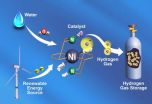Polar climate change may lead to ecological change
2011-08-12
(Press-News.org) Ice and frozen ground at the North and South Poles are affected by climate change induced warming, but the consequences of thawing at each pole differ due to the geography and geology, according to a Penn State hydrologist.
"The polar regions, particularly the Arctic, are warming faster than the rest of the world," Michael N. Gooseff, associate professor of civil and environmental engineering, told attendees today (Aug. 11) at the 96th annual meeting of the Ecological Society of America in Austin, Texas. "As a consequence, polar ecosystems respond directly to changes in the earth systems at the poles."
These changes, though different at each pole, could be significant in their effects on not only the local environment, but also globally. While the central part of the Arctic is composed of ice over water, northern Canada, Alaska, Siberia and Greenland all have landmasses within the Arctic Circle. The associated land and water ecosystems are affected by melting ice and thawing soils, but in Antarctica, where much of the ice overlays a continent, the warming alters streams, lakes and the tiny plants and animals that live there.
"Our focus on the north is in part because it is inhabited, but it is also because the ice there is more vulnerable," said Gooseff. "Temperatures and snow and rain across the tundra shifts annually and seasonally. We know that fall is beginning later than it once did."
In the Arctic, where there is more immediate feedback from the higher temperatures, the warming is degrading permafrost, the layer of the ground that usually remains frozen during annual thawing events. This causes creation of a boggy, uneven landscape with a disturbed surface. Subsequent rain or snowmelt can erode this surface carrying silt and sediment into bodies of water, changing the paths of rivers and streams. Debris flows are also a common occurrence in degraded permafrost areas.
"Algae, insects and fish all must deal with this increased level of sediments," said Gooseff.
Extended frost-free time causes soils that do thaw annually to have longer active periods when microbes can mineralize nutrients. While the soils remain frost free longer, plants continue their normal cycle dictated by the length and intensity of daylight, which has not changed. Microbes may continue to create nutrients, but the plants no longer use them, so that when rain or meltwater comes the nutrients leach into the rivers and streams.
"That is exactly what we are seeing," said Gooseff. "In September and October, we see a substantial increase in nutrients in the water. Concentrations increase many times for nutrients such as nitrate and ammonium."
Another problem with degrading permafrost is the release of the carbon that was permanently trapped in frozen organic materials in the frozen ground. Warming will eventually liberate carbon dioxide and methane into the atmosphere.
"It is estimated that the permafrost contains twice the amount of carbon that is currently in our atmosphere," said Gooseff.
We think of Antarctica as a vast empty place, but lakes and streams exist in several polar desert oases, including the McMurdo Dry Valleys. These bodies of water are filled with a variety of life including microbial mats, plankton and filamentous algae.
"While there are no bugs or fish in these waters, there are diverse microbial communities," said Gooseff. "Some algae in the dry valleys go dormant for nine months or more and then begin to grown when hit by meltwater."
Because there is so much permanent ice in Antarctica, the annual impact of increased temperatures on its environment is slower than in the Arctic. The huge expanse of white ice reflects some of the heat energy into the atmosphere.
"We expect in the next several decades that we will see the Antarctic start to warm up," said Gooseff.
The Antarctic permafrost is very dry with high nitrogen concentrations in some places. When water reaches some of these dry soils, it will mobilize the nutrients and increase potential habitat for freshwater aquatic communities in Antarctica. This climate change will alter the flow patterns, expand the stream networks, and change both the location of habitats and the timing of life cycles.
"Beside the information that we can obtain about climate change on Earth, understanding what happens in Antarctica is important to understand what happens on Mars," said Gooseff. "There is potential for microbial communities on Mars, and if they exist they will probably be similar to the McMurdo Dry Valley communities."
###The National Science Foundation Office of Polar Programs supported this work.
ELSE PRESS RELEASES FROM THIS DATE:
Like humans, chimps are born with immature forebrains
2011-08-12
In both chimpanzees and humans, portions of the brain that are critical for complex cognitive functions, including decision-making, self-awareness and creativity, are immature at birth. But there are important differences, too. Baby chimpanzees don't show the same dramatic increase in the volume of prefrontal white matter in the brain that human infants do.
Those are the conclusions of a study reported in the August 11th Current Biology, a Cell Press publication, that is the first to track the development of the chimpanzee brain over time and to make the comparison to ...
For bugs within bugs within mealybugs, life is a 'patchwork'
2011-08-12
Bacteria may have bad reputations but in fact, all animals -- us included -- rely on them in critical ways. In the case of sap-feeding insects, intimate associations with microbes offer a source for essential nutrients that their sugary diets just don't include. Now, researchers reporting in the August 11th Current Biology, a Cell Press publication, have new insight into organisms that have taken this symbiotic lifestyle to the extreme; they have sequenced the genomes of two species of bacteria that live together, one inside of the other, inside mealybugs.
The effort ...
Catalyst that makes hydrogen gas breaks speed record
2011-08-12
RICHLAND, Wash. -- Looking to nature for their muse, researchers have used a common protein to guide the design of a material that can make energy-storing hydrogen gas. The synthetic material works 10 times faster than the original protein found in water-dwelling microbes, the researchers report in the August 12 issue of the journal Science, clocking in at 100,000 molecules of hydrogen gas every second.
This step is just one part of a series of reactions to split water and make hydrogen gas, but the researchers say the result shows they can learn from nature how to control ...
Stick-on tattoos go electric
2011-08-12
VIDEO:
The video describes the new epidermal electronics system and shows how it is applied to the skin.
Click here for more information.
Through a combination of careful theoretical modeling and precise micro-manufacturing, a team of engineers and scientists has developed a new type of ultra-thin, self-adhesive electronics device that can effectively measure data about the human heart, brain waves and muscle activity – all without the use of bulky equipment, conductive ...
URALCHEM HOLDING P.L.C. Reports The First Half Of Year 2011 Unaudited IFRS Financial Results
2011-08-12
- Revenue increased to US $ 1.035 billion, compared to US $ 663 million
in H1 2010
- Operating profit increased to US $ 288 million, compared to US $ 83 million
in H1 2010
- Adjusted EBITDA grew to US $ 337 million, compared to US $ 137 million
in H1 2010
- Net profit amounted to US $ 244 million, compared to net loss of US $ 13 million in H1 2010
URALCHEM Holding P.L.C. (hereinafter URALCHEM Holding or the Company), a Cypriot holding company of the URALCHEM Group (hereinafter called the Group), one of the largest producers of nitrogen and phosphate fertilisers ...
Smart skin: Electronics that stick and stretch like a temporary tattoo
2011-08-12
VIDEO:
A new form of electronics, small enough to fit under a temporary tattoo, changes the way scientists think about gathering data from the human body.
Click here for more information.
CHAMPAIGN, Ill. — Engineers have developed a device platform that combines electronic components for sensing, medical diagnostics, communications and human-machine interfaces, all on an ultrathin skin-like patch that mounts directly onto the skin with the ease, flexibility and comfort of ...
Natural History Museum of Los Angeles County makes scientific history with 'pregnant plesiosaur'
2011-08-12
August 7, 2011 – A paper to be published on August 12, 2011 in the authoritative magazine Science reveals that Dr. F. Robin O'Keefe of Marshall University in Huntington, W.Va. and Dr. Luis Chiappe, Director of the Natural History Museum's Dinosaur Institute, have determined that a unique specimen now displayed in NHM's Dinosaur Hall is the fossil of an embryonic marine reptile contained within the fossil of its mother.
The 78-million-year-old, 15.4-foot-long adult specimen is a Polycotylus latippinus, one of the giant, carnivorous, four-flippered reptiles known as plesiosaurs ...
NIH-led team maps route for eliciting HIV-neutralizing antibodies
2011-08-12
Researchers have traced in detail how certain powerful HIV neutralizing antibodies evolve, a finding that generates vital clues to guide the design of a preventive HIV vaccine, according to a study appearing in Science Express this week. The discoveries were made by a team led by the Vaccine Research Center (VRC) at the National Institute of Allergy and Infectious Diseases (NIAID), part of the National Institutes of Health.
"This elegant research brings us another step closer to an HIV vaccine and establishes a potent new technique for evaluating the human immune response ...
Supernovae parents found
2011-08-12
Pasadena, CA— Type Ia supernovae are violent stellar explosions whose brightness is used to determine distances in the universe. Observing these objects to billions of light years away has led to the discovery that the universe is expanding at an accelerating rate, the foundation for the notion of dark energy. Although all Type Ia supernovae appear to be very similar, astronomers do not know for certain how the explosions take place and whether they all share the same origin. Now, a team of researchers has examined new and detailed observations of 41 of these objects and ...
Depression linked to increased risk of stroke in women
2011-08-12
Depressed women may face an increased risk of stroke, according to new research reported in Stroke: Journal of the American Heart Association.
In six years of follow-up of women in the Nurses' Health Study, researchers found that a history of depression was associated with a 29 percent increased risk of total stroke – even after considering other stroke risk factors. Women who used anti-depressant medication — particularly selective serotonin reuptake inhibitors— had a 39 percent increased risk of stroke. Examples of these drugs are Prozac, Zoloft, and Celexa.
Anti-depressant ...

